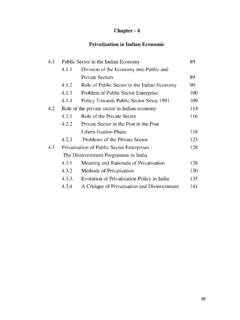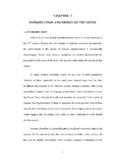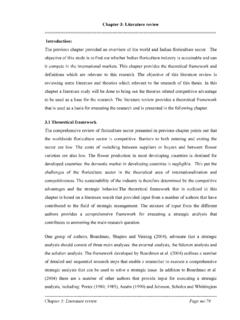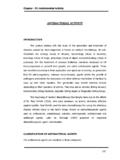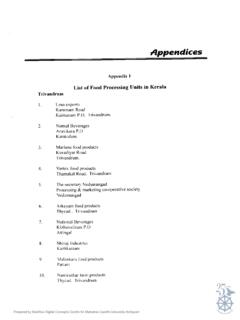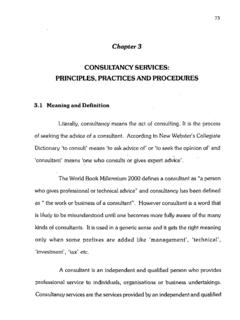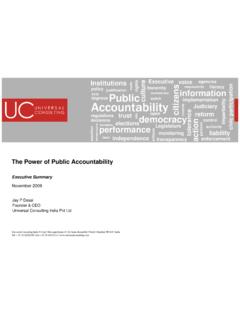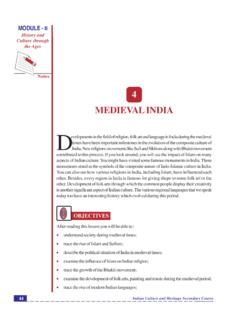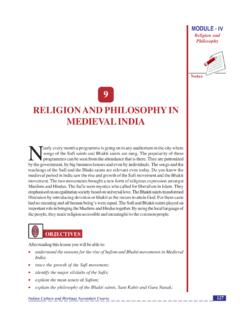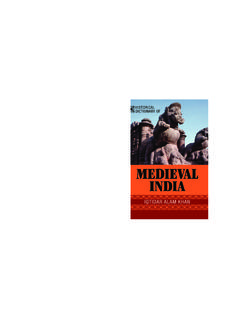Transcription of School Education System in India before and after ...
1 CHAPTER- 3 School Education System in India before and after Independence Change does not necessarily assure progress, but progress implacably requires change. Education is essential to change, for Education creates both new wants and the ability to satisfy them Henry S. Commager The educational institutions which provides the primary Education to the maximum number of children is the world largest single enterprise. With the involvement of a bit array of teachers, the biggest number of pupil, a large number of supervisors and administrators, this kind of institution is able to change the social value of human life with the help of Education . As such, from the point of view of magnitude, from the stand point of psychological preparedness, from the preponderance of the sociological influences, in view of the economic necessities, and the philosophical background and in view of scientific enlightenment and humanism, the role of primary Education is extremely significant and crucial.
2 Education works as a lever in raising financial and social status of the individuals. So, expenditure on Education is regarded as useful investment not only by the economists, but also by the educationists. Economic condition of a country depends largely on the educational standards of its people since primary Education is the foundation and should be the maximum or basic acquisit io n for the majorit y. Education is the root of modernization and human development. Education is a process of learning and it continues throughout the life. It promotes mobilization and encourages people to participate in development activities. Education makes people skilled towards jobs and creates productive efficiency. So to know the practice of Education in India , this chapter has been divided into two parts: Education in India before independence that includes Education in all the three historical phases namely ancient, medieval and modern India ).
3 Likewise, another part basically deals with Education in India after her independence. 95 Education in India before Independence: The cultural and the traditional Education were started from the beginning of the human civilization. Although the pattern of learning was different from today s curriculum yet, no one can deny that the human civilization was elaborated in a parallel manner in the presence of cultural and the traditional Education . (a) Education System in Ancient Period Every aspect of life including Education in ancient India was influenced by religion. However, it is worth to mention that Education aimed at many sided development of the personality of the student of course with a religious orientation. The concept, aims and ideals of Education were correlated with the ideals of life. Religion played an imperative part in life in ancient India . The whole social structure of those days was religious and the whole System of Education surged with religious atmosphere.
4 Teachers were usually priests, so they provided Liberal, Spiritual and Religious Education . In ancient India the whole System of Education ran on the specific System o f inst itution called GURUKUL System OF Education 1 .The main sources of teaching in the ancient Education were Vedic literature which represent the most important and intrinsic part of life of the Indian people. In Vedic period, as the period is known, teacher or Guru used to give knowledge to their pupil on the basic of Vedic literature which consisted of eight different forms; they are Four Vedas, Six Vedangas, Four Upavedas, Four Brahmanas, One hundred and eight Upanishads, Six systems of Philosophy, Bhagwad Gita, and Three .The Vedas deal with every branch of knowledge and provide basic material of all arts and science. In fact, they are the first source of wisdom. Ancient educators considered knowledge as the third eye of man which gives him insight into all worldly and non- worldly matters3.
5 Teacher occupied a vital position in the Vedic System of Education . The teacher was a parent surrogate, facilitator of learning, exemplar and inspirer, confident, detector friend and philosopher, evaluator, imparter of knowledge and wisdo m and above all a guru, religious and spiritual guide. In Vedic period forest was treated as a centre of Education , which was far from the madding crowd s ignoble strife4. In ancient time people used to live a simple and a pious life. They used to perform their dut ies and responsibilities with utmost care and devotion. Everyone had 96 Estelarcertain moral values and they considered following religion norms as their duty. They used to live in closed contact with saints, which made their life religious5. Under ancient or more particularly Vedic Education process, all human beings would make necessary or positive changes in their behaviours. It was with feelings of love and devotion that atmosphere of educational institution was charged with.
6 An important objective of ancient educational System was to preserve and transmit ancient Indian culture. This task was being performed by renowned teachers, who used to engage in their work continuously. Habits of performing various functions independently were developed in student, which used to help them in uplifting their future life. The ancient Education System had been able to develop the all-round behaviour of student. Though, the System did not have a written curriculum yet, Gurus would choose those activities that helped to develop different dimensions of student s personality. To reiterate, the overall System of Education in ancient India was based on Vedas. Vedas are considered to be main source of Indian philosophy of life. Amo ng the four Vedas, the Rig Veda is considered as most fundamental from point of Education as it is in this Veda that knowledge aspect is being interpreted and four stages of human life are also dealt in the Rig Veda6.
7 In the Gurukul System of Education , the Brahmin Gurus or teachers taught children of only three upper casts of Aryan society, namely, Brahmins, Kshatriyas and Vaishyas. The Education for non-Aryans was kept in dark, although they are in the majority among the Indian populace. The majorit y o f the pupils were boys or male, but there was a provision for the girl s Education also, but the number of schools or Gurukul which were exclusively for girls were very few in those Mohit Kumar justifies: Later on the ancient or Gurukul System of Education was imparted on the basis of caste of the student. Brahmins were given the knowledge about religion, philosophy, Vedas. Ultimately they are in the top line of the social structure of the society. Kshatriyas, the people of warrior class, were taught various concepts of warfare, (the army of the ancient India ). The third group of the society was Vaishyas, the people from the business line and they used to learn various techniques and principles necessary for smooth running of the business and for the last group of the society called Shudras, the right to Education for them were not given.
8 8 So in ancient period the Indian society was divided into four different Varnas also known as Chatur Varna on the basis of their work. That is why the Brahmins worked as the teachers and the priest of the temples. The subjects of the ancient 97 Estelareducation were basically Philosophy, grammar and The System of Education in those days was not only theoretical but a practical content that included meditation, seminars, and religious practices. With the combination of theoretical knowledge and the practical knowledge the pupil used to develop the healthy civic and aesthetic sense and it was impossible to lead a successful life without it. after getting Education fro m Gurukuls, students were empowered to get married and lead a family life. after marriage the civil life used to begin, from there onwards it became their duty to obey all the norms and values set by the society. To perform various kinds of duties towards their family and for the society was their prime responsibility, for which they were being educated in Gurukuls.
9 Some of the Chief aims and ideals of ancient Indian Education are highlighted by Gupta in the following manner: a) Infusio n of a spirit of piety and righteousness, b) Formation of high character, c) Development of personality, d) Inculcation of civic and social values, e) Promotion of social efficiency and f) Preservation and spread of national In ancient India the above mention aims and the ideals are fulfilled by the ancient Education System called Gurukul System of Education . Although the Brahmins were in the dominant position but the society of ancient India was maintained by every individual. Every member of the society performed their duties with full of loyalty and responsibility. During that time, common people had an intellectual outlook that naturally was varied from today s materialistic conception. Self-study, thinking, and meditation were the activities in which common man used to spend much of his time.
10 Religious Education was very important through which they believed that they would attain salvation. The overall feature of ancient Education was based on Hindu religion which gives not only the religious based Education but also provides the knowledge of human life, and also made conscious about the deeds of human life. In the ancient Education females were also allowed to get Education along with their male counterparts. Kaushalya mother of Rama, Tara wife of Bali, Draupadi wife of Pandavas, are some of the examples of educated women in ancient Similarly, 98 Estelareducation in ancient India was free from the interference of the any high authority because the management of Education was completely a private concern and was strictly under the control of a Brahmins. Funds for the Education were received from the public in the form of Vidyadana (donation), which was pronounced to be the best of all gifts.

